
Writing a script is intimidating, but actually, breaking the process into small steps makes it MUCH EASIER and will result in a MUCH BETTER story. This lesson shows you how to plan and write a script. It is highly recommended that you use this lesson when students are working on a story. This lesson has several parts. These Scripting Slides can be used throughout the lessons. You might use some or all. Each will take about 50 minutes.
Students gain a much deeper understanding of media and news when they have to make editorial decisions through writing and editing their scripts
Understanding how media is constructed is key for critical thinking. Deeper knowledge of the story-telling process helps students recognize the role of stories in our understanding of how government and society work.
If your students do not have a script to work with, use the Mighty Greens materials from a Student Reporting Labs story about a youth-led garden and entrepreneurial cooperative.
A person or other physical being in a narrative. Stories are made up of different characters who provide information and help shape the narrative with their knowledge, experience and perspective.
A document with transcribed (written-out) soundbites and voiceover narration. A VIDEO script is a two-column document with the audio (soundbites and voice over) in the right-hand column and a description of what the audience sees (visuals) in the left-hand column.
Narration done by a broadcast reporter, usually reading from a script. The reporter's voice is recorded over a sequence of video clips that tell a story.
A short extract or clip from a recorded interview, chosen for its relevance to the story, pungency or appropriateness.
Sounds produced in their actual setting. Natural sound, commonly known as NAT sound, puts the viewer in the place the story was told by enhancing the scene(s) with video containing rich audio such as a musician singing at a train station, a storm approaching, or the sound of a tractor plowing the field.
A word-for-word document of what was said in a conversation or interview
A person who gives an account or tells the story of events, experiences, etc. In news, it is the person who adds spoken commentary to the video news story.
The main person or character in a story. There can be multiple subjects in a story. The subject can also be the main theme of your story.
A detailed analysis and assessment of something.
An example of using a little person to tell a big story. For example, you want to tell a story about pollution in your community’s water system. That is a big issue. Your video will use the story of a person (character) to illustrate the effects of bad water quality.
An attempt to grab the reader or viewer’s attention with interesting information that will keep them reading or watching.
The supplemental footage used to visually support your A-ROLL.
Search: broll.
Civics teaches the principles—such as adherence to the social contract, consent of the governed, limited government, legitimate authority, federalism, and separation of powers—that are meant to guide official institutions such as legislatures, courts, and government agencies. (NCSS D2.Civ.7.9-12 - D2.Civ.10.9-12)
Students critically curate a variety of resources using digital tools to construct knowledge, produce creative artifacts and make meaningful learning experiences for themselves and others. (ISTE)
Whether students are constructing opinions, explanation, or arguments, they will gather information from a variety of sources and evaluate the relevance of that information. (NCSS D3.1.9-12 - D3.2.9-12)
Students communicate clearly and express themselves creatively for a variety of purposes using the platforms, tools, styles, formats and digital media appropriate to their goals. (ISTE)
Journalism
Video Production
Media Literacy
Lessons
Beginner
Intermediate
Advanced
White board, chalkboard or other visual board
Slides
Online Worksheet
Internet
4-8 Classes
Explain to students that this is where their story comes together: writing a script is key to a successful project. It is what professional video journalists do and it is expected in a journalism class. This lesson breaks script-writing down into small, manageable steps so that you don’t have to be scared or intimidated.
It should also be creative and fun. The key is to transcribe your interviews, highlight the best soundbites and then arrange them to form a story arc with a beginning, middle, and end. All the while, you are thinking of your audience:
Transcription is a word-for-word document of what was said in a conversation or interview. The Student Reporting Lab at Etiwanda High School in California produced this 2-minute video about transcription.
Student Reporting Labs recommends using the following sites for transcription:
Follow the instructions on the site - either upload the audio file from your phone or export an audio file (usually .wav) and upload.
NOTE: transcription sites are just the first step and always contain multiple mistakes. Students must correct the transcription by listening word-for-word and fixing the document. Challenge students find the most ridiculous mistake (for example, “purple people eaters” instead of “movie theaters”).
Watch the video while referring to the transcript and note any strong facial expressions, laughter or other emotions. Using emojis is a fun way of noting what the speaker is expressing to the audience. These notations will make it easier to edit because you will know what you want and where it is.
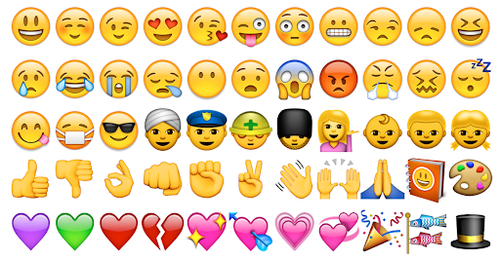
Once you have corrected your transcripts, it’s time to highlight the best parts. This can be done individually or as a group, digitally or on paper (highly suggested). Remember, you can use b-roll and other visuals to cover audio edits. This means that even if the soundbite is not complete, you might be able to use a part of it. This will become clear when you write your script.
If your students don’t have a script, use this one about Mighty Greens found in the lesson resources, a youth garden and entrepreneur cooperative in Washington, DC. Cut out the best sound bites and arrange them: beginning, middle, and end.
These are the questions you will ask yourself as you figure out the outline of your script:
Even with the best planning, what you have when you get back from shooting video is different than what you expected. If you are very lucky you got 80% of what you wanted and 20% that you never anticipated. The question is, do you have what you need to tell a great story or do you need another interview/ more b-roll?
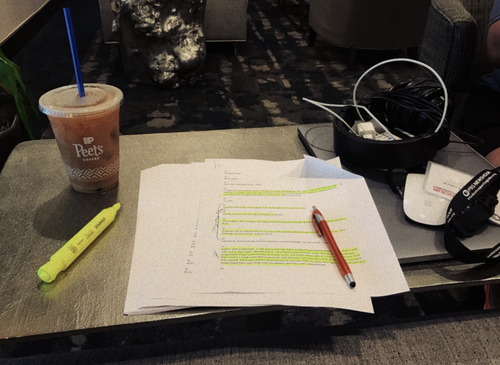
Student Reporting Labs recommends that you print out your transcripts and cut up the soundbites with scissors so that you can arrange the beginning, middle, and end. Only when you can truly move soundbites around can you progress from the story you wanted…to the best story you can do with the video you recorded.
This section is also divided into stories produced by teams and stories produced by an individual.
Paper cut
After you’ve highlighted your best sound bites, cut them out. Make sure each bite notes the name of the person who is talking, and if possible the timecode.
Use a big piece of paper, or just organize your soundbites on a big surface according to Beginning, Middle, and End. Move the soundbites around and start to write connections between the sound bites. Do you need Voice Over (see below) for your story to make sense (most of the time you do)?
Digital cut
If you can’t cut your transcript with scissors, you can use a google doc or other format to move soundbites around.
Use a Jamboard to create a story arc
If working in a group, use video calls to discuss while editing together.
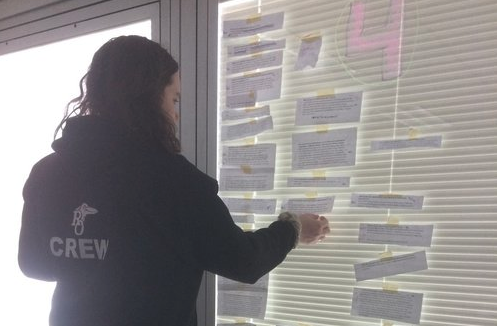
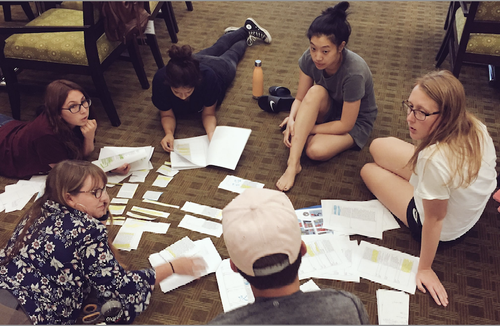
If you find yourself struggling to find your beginning, middle and end, try a Classic Story Arc. This is an example of using a little person to tell a big story. For example, you want to tell a story about pollution in your community’s water system. That is a big issue. Your video will use the story of a person (character) to illustrate the effects of bad water quality. The Classic Story Arc is:
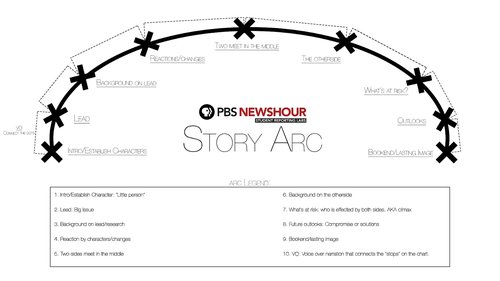
Voice Over = VO and it is the narrator of the story. Usually, it’s the reporter filling in details between soundbites. A few ways to think about VO:
VO is best written by one person, one voice, one writing style. Try not to start your story with VO. It’s much better to hook your audience right in with a fantastic soundbite or compelling natural sound.
Once you have written Voice Over, ask yourself these questions about each line.
Students figuring out the VO to connect the soundbites
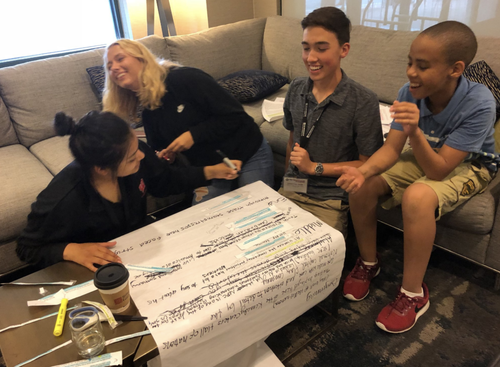
Use the Mighty Greens Script WITHOUT VO and Mighty Greens Script WITH VO to explore and discuss how each line of VO works to move the story forward.
Now it’s time to put all your planning and thinking together and write a script. A script has two columns. You can use and make a copy of SRL's Script Template. What you see is on the left and what you hear is on the right. Write your VO in CAPs and your soundbites in lower case. (Note SOT refers to Sound On Tape, otherwise known as your soundbites)

Scriptwriting gets easier the more you do it.
If this is your first time, share the hardest part and what you hope gets better.
If you have written scripts before, how did this set of resources and slides help?